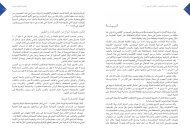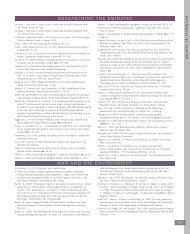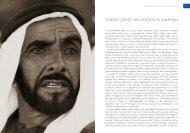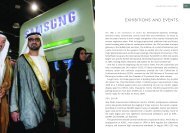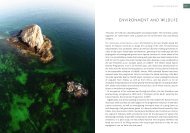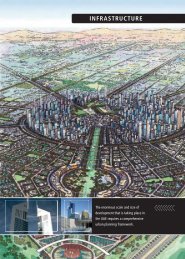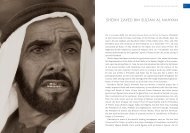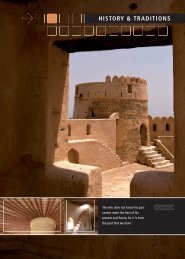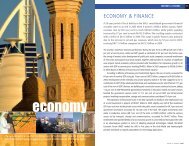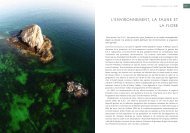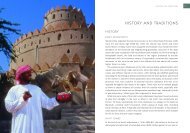136UNITED ARAB EMIRATES YEARBOOK 2006<strong>ECONOMIC</strong> <strong>DEVELOPMENT</strong>137known structures and exploration purposes to find new reserves and a 3D surveyof the Bab field to improve reservoir characterisation and help optimise developmentschemes. The main focus on future exploration/ appraisal is in the south-eastportion of ADCO’s concession and undeveloped reservoirs overlying/ underlying orproximate to reservoirs currently on-stream.ADCO is currently undertaking expansion projects to add some 400,000 b/dto its sustainable crude oil production capacity. These include expansion of theonshore Bab field (adding 100,000 b/d of facilities) to achieve a sustainable capacityof 350,000 b/d by early 2005 and full field development of four north-easternfields (Al Dabb’iya, Jarn Yaphour, Rumaitha, Shanayel) to increase their capacityfrom 10,000 b/d to 110,000 b/d. The work is scheduled for completion in the firstquarter of 2006 and will provide sustainable capacity of 70,000 b/d at the AlDabb’iya and Jarn Yaphour fields and 40,000 b/d at the Rumaitha/Shanayel fields.Work planned to be completed in February 2006 at the Bu Hasa field, to replaceageing production facilities and enhance pressure maintenance schemes, involvesgas and water injection facilities with a capacity of 150 million standard cubicfeet/day of gas and 120,000 barrels water per day. It is expanding capacity of theBu Hasa field by 180,000 b/d, from 550,000 b/d to 730,000 b/d.Work on Huwaila, located 30 kilometres south of the Bu Hasa field, began inAugust 2003. The field’s Shuaiba Unit H reservoir enters production in 2006 ata designed rate of 10,000 b/d. Additional wells are due to be drilled in 2007.This is an innovative development using multiphase pumps to deliver the fluids(oil/water and gas) to Bu Hasa where they are separated and processed. Thesecond phase of development of the Sahil field will also add 20,000 b/d capacityby 2008. Development work at the Asab field, aimed at boosting production by30,000 b/d, has also been progressing. Water injection facilities at the field havebeen renovated by Veco Engineering, which also holds a contract for maintenanceof 1311 wells at various fields operated by ADCO.The recently completed work undertaken to increase capacity of the Bab fieldfrom 250,000 b/d to 350,000 b/d involved installation of two new processingtrains, two-phase and three-phase gas/oil separator plants, a new central degassingstation and associated pipelines. Meanwhile, gas injection at the field was increasedby 120,000 cf/d, from 280 million cf/d to 400 million cf/d.Abu Dhabi already applies the most up-to-date production and drilling technologyat its oilfields. Both water and gas injection are in wide use at older fields tosustain reservoir pressure and maintain flow rates. Moreover, operators are drillinga growing number of horizontal wells to improve well productivity and boostrecovery rates. Many of these, particularly in the Rumaitha and Al Dabb’iya fields,are drilled as clusters from a relatively small area and the wells deviated to theirtarget zones to minimise the surface footprint. This reduces field congestion andcontributes to ADNOC Group’s environmental protection programme.Abu Dhabi’s operating companies have acquired considerable expertise indirectional drilling methods and utilise short, medium and long radius drillingtechniques in conjunction with both oriented and conventional coring. The longesthorizontal hole drilled in Abu Dhabi was an 1830-metre section drilled by ADCO.Whilst the prime responsibility for gas field development and production inAbu Dhabi is that of GASCO and ADGAS (see section on gas below), ADCO also hassome involvement in development of gas fields and undertakes production andprocessing of gas on behalf of ADNOC. Gas is presently recovered from the Asaband Bab fields. Bab presently yields around 3 billion cf/d of gas, whilst Asabproduces 826 million cf/d, bringing onshore gas production managed by ADCOto around 4 billion cf/d. Meanwhile, ADCO is tackling increasing corrosion atits onshore fields. In February 2004 it awarded a US$50 million contract to aconsortium specialising in this area. They are tasked with providing cathodicprotection for approximately 1500 wells and are scheduled to complete the workin 2007/08.ADMA-OPCOThe Abu Dhabi Marine Operating Company (ADMA-OPCO) is the second biggestoil producer in the <strong>UAE</strong> after ADCO. The two companies account for more than80 per cent of Abu Dhabi’s total crude oil production. ADMA-OPCO is responsiblefor development and operation of the Umm Shaif and Lower Zakum offshore fields.With an area of 360 square kilometres, Umm Shaif has 268 producing wells andis located about 140 kilometres north-west of Abu Dhabi City. The Lower Zakumfield, covering 1270 square kilometres, has 321 wells tapping into five productivezones. It currently produces 220,000 b/d, making it one of the largest offshoreoil fields in the world. Water injection is used to maintain pressure in the reservoir.Lower Zakum and Umm Shaif have rated capacities of 320,000 b/d and280,000 b/d respectively, but their sustainable capacities are considered to beapproximately 240,000 b/d and 220,000 b/d respectively. The company currentlyproduces around 420,000 b/d of oil that is obtained via multiple wells tappinginto the productive zones. Current plans are to raise their sustainable capacitiesto levels that were previously regarded as their maximum levels. This is beingachieved through drilling of new production and injection wells and construction ofprocessing and compression facilities to extract gas from the field’s Khuff reservoirand re-inject it into the Arab C and D oil reservoirs. Scheduled for completion in2006, the project will double the gas injection capacity of the Umm Shaif field.ADMA-OPCO commissioned a 1500-square-kilometre seismic survey of theseabed in the Zakum field. The aim was to boost productivity of both parts of theZakum structure through enhanced reservoir definition. In addition, the surveycould provide the baseline for a future time-lapse 3D reservoir monitoringprogramme. Current development of the Zakum field is utilising this data.
138UNITED ARAB EMIRATES YEARBOOK 2006<strong>ECONOMIC</strong> <strong>DEVELOPMENT</strong>139Zakum Development Company (ZADCO)ZADCO was established in 1977 to develop and operate the Upper Zakum field, oneof the largest oil fields in the world, on behalf of ADNOC and Japan Oil DevelopmentCompany (JODCO). Besides Upper Zakum, the company also operates the Ummal-Dalkh and Satah fields. Upper Zakum, Abu Dhabi’s largest oil field with anestimated reserve of 50 billion barrels of oil, is of considerable significance inrelation to Abu Dhabi’s intention, supported by a US$10 billion investment,to increase its oil production capacity from a level of 2.5 mb/d in early 2004 tobetween 2.85 and 3 mb/d in 2006 and 3.7 mb/d by 2010. Upper Zakum’sproduction capacity is set to increase from its present level of 550,000 b/d to750,000 b/d by 2006/07. Oil and associated gas from all three fields are piped toZirku Island for final processing, storage and shipping. Facilities on Zirku arebeing upgraded. Debottlenecking has increased their efficiency and raised capacityfrom 600,000 b/d to 800,000 b/d, thus enabling them to handle the plannedincrease in ZADCO’s production.Despite the large size of the Upper Zakum field (50 billion barrels of crude oil inplace), relatively low pressure and poor porosity of the rock has restricted recoveryrates. Large-scale use of water injection as well as gas injection has been employedto counter these difficulties. Using gas to inject into oil bearing reservoirs, increasingthe pressure and enhancing flow rates is clearly more feasible in the <strong>UAE</strong> than incountries lacking the <strong>UAE</strong>’s vast reserves of natural gas and oil in close proximity.Abu Dhabi Oil Company (ADOC)ADOC, owned by a consortium of Japanese oil companies, operates three offshoreoil fields, Mubarraz, Umm al-Anbar (referred to as AR) and Neewat al-Ghalan(referred to as GA), located 60 to 100 kilometres west of the coast of Abu DhabiCity. Sweet gas has been injected to AR and GA fields for enhanced oil recoverysince the start of production. Concurrently, 10 million standard cubic feet perday (mmscf/d) of sour and acid gas, extracted via a gas-sweetening unit, wasflared at AR site terminal until 2000. However, ADNOC environmental regulationsmeant that such flaring was no longer acceptable and an alternative solutionwas required. The option selected was to inject the sour gas previously flared intoexisting oil reservoirs.The sour gas injection facilities include two parallel compression trains, each of20 mmscf/d, and a common sour gas dehydration unit of 40 mmscf/d capacity.Currently, the sour and acid gas separated at AR site terminal is being injectedinto the oil reservoirs of AR and GA fields on a continuous basis. Injection of thesour gas has significantly enhanced oil recovery from the AR and GA fields.In parallel to the sour gas injection project, ADOC has implemented a secondproject known as the zero gas-flaring project. This recovers sour gas flared atMubarraz Offshore and Mubarraz Island for injection into the oil reservoirs of ARand GA fields via the sour gas injection facilities. The zero gas-flaring project wascompleted in April 2001 and the continuous gas injection from both Mubarrazoffshore and Mubarraz Island continues. As a result of the combined efforts withboth the sour gas injection and zero gas flaring projects, almost all the sour gasproduced from ADOC’s oil fields is now being recovered and injected into the oilreservoirs of AR and GA fields.The Mubarraz, West Mubarraz and Neewat al-Ghalan fields presently producearound 31,000 to 32,000 b/d of crude oil.Al Bunduq Oil Company (BOC)The Al Bunduq field straddles the maritime border between Abu Dhabi and Qatar.In May 1969, Abu Dhabi and Qatar agreed to share revenues accruing from thefield’s oil production on an equal basis. Al Bunduq produces approximately 12,000to 15,000 b/d for Abu Dhabi.Total Abu al-Bukhoosh Oil Company (TBK)Total Abu al-Bukhoosh Oil Company was set up to develop the Abu al-Bukhooshfield discovered by ADMA-OPCO in 1969. The field now yields around 25,000 b/dof crude.DubaiDubai has installed enhanced recovery systems and other facilities to maximiseflow rates at its oilfields in a bid to slow the decline in production. Furtherdevelopment work is taking place at the Margham gas field to stem the fall ingas/condensate output there. Dubai Petroleum Company (DPC), by far the largestproducing venture in the emirate, has drilled infill wells and horizontal productionwells to boost recovery at four main oilfields, Fateh, Southwest Fateh, Rashidand Falah, which are all located offshore. There have been some impressivesuccesses, for example the tripling of production at Falah D from 10,000 b/d to30,000 b/d following horizontal drilling at the site. Faced with limited resourceswithin its own territory, Dubai has also been looking elsewhere for opportunitiesin oil exploration and development. One such venture is that of Dragon Oil (anIrish-registered company in which Emirates National Oil Company (ENOC) has a51 per cent shareholding), which has an interest in oil production in Turkmenistan,where its production reached around 20,500 b/d by the end of 2004, up from13,217 b/d in 2003 and 10,383 b/d in 2002. It expects production at these facilitiesto reach 40,000 b/d by 2008/09.SharjahSharjah’s main hydrocarbon production is in natural gas and the emirate’s onlyoil field is the offshore Mubarak field, which has been in production since 1974.A steady decline in production at this field led Crescent Petroleum to embark on asecondary development programme that entailed drilling more wells, including



